You searched for: 加拿大28怎么做代理【亚博官方qee9.com】时时彩5星组号工具V4L
<< Previous | Displaying results 111-120 of 377 for "加拿大28怎么做代理【亚博官方qee9.com】时时彩5星组号工具V4L" | Next >>
-
View of the refugee camp in Zbaszyn
PhotoView of the flour mill in Zbaszyn, which served as a refugee camp for Jews expelled from Germany. The Jewish refugees, hungry and cold, were stranded on the border, denied admission into Poland after their explusion from Germany. Photograph taken between October 28, 1938, and August 1939. Warsaw-based historian, political activist, and social welfare worker Emanuel Ringelblum spent five weeks in Zbaszyn, organizing assistance for the refugees trapped on the border.

-
Destruction of the Lodz Ghetto
Timeline EventBeginning on August 9, SS and police units liquidate the Lodz ghetto.
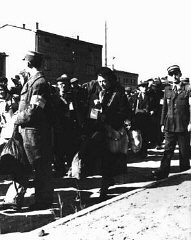
-
Germany invades Poland
FilmGermany invaded Poland on September 1, 1939, beginning World War II. Quickly overrunning Polish border defenses, German forces advanced towards Warsaw, the Polish capital city. This footage from German newsreels shows German forces in action during the invasion of Poland. Warsaw surrendered on September 28, 1939.
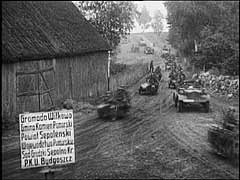
-
Mauthausen
ArticleThe Mauthausen concentration camp was established following the Nazi incorporation of Austria in 1938. Learn about the harsh conditions in the camp.

-
The Holocaust in Macedonia: Deportation of Monastir Jewry
ArticleIn March 1943, Bulgarian authorities transported the entire Jewish community of Monastir to a transit camp from which they were deported to Treblinka.

-
Second telegram from the Chief Rabbi of Vilna asking for aid
DocumentA second RCA Radiogram telegram from Rabbi Grodzenski, Chief Rabbi of Vilna, to the Central Relief Committee in New York. He requests aid for refugees who have gathered in Vilna. The telegram says that more than 1,600 yeshiva students and their families from over 10 cities throughout Poland have fled to Vilna, where they remain in terrible living conditions. November 5, 1939. [From the USHMM special exhibition Flight and Rescue.]
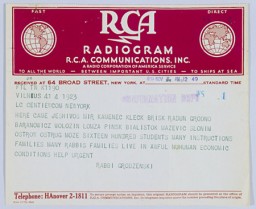
-
Wool Bedcover
ArtifactFollowing the Soviet occupation of Lithuania, the Lifszyc family began to search for ways to leave the country. David Lifszyc obtained a Curacao visa from the Dutch consulate. He also obtained an American visa because he was included on a list of distinguished rabbis submitted to the State Department by the Agudat Israel of America. After obtaining Soviet exit visas, the Lifszycs purchased tickets for Vladivostok on February 5, 1941. They started for Moscow, where they received Japanese transit visas. This…
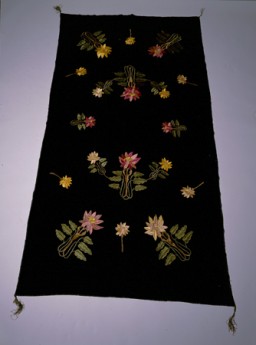
-
Beifeld album page illustrating fortifications and first fatality
Artifact(Bottom) View of fortifications built at Kalimovka to defend the advancing troops of the 4th Infantry Division of the Hungarian 2nd Army. In the lower right corner of the drawing, men prepare the grave of Jewish Labor Serviceman Nandor Klein, the first fatality of the company. The Hungarian caption reads: The death of our first hero, Nandor Klein, his grave, June 5, 1942." Klein was killed by a stray Soviet bullet on his way back to base. [Photograph #58013]

-
Adolf Hitler greets Paul von Hindenburg
PhotoRecently appointed as German chancellor, Adolf Hitler greets President Paul von Hindenburg in Potsdam, Germany, on March 21, 1933. This pose was designed to project an image of Hitler as non-threatening to the established order. This particular image is from a popular postcard. The photo also appeared widely in both the German and international press. Hitler appears in civilian dress, bowing in deference to the heavily decorated von Hindenburg. The March 5, 1933, elections had conferred legitimacy on…
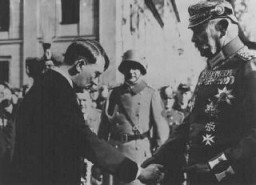
-
Auschwitz I camp, 1944
MapSelected Features 1. Camp Commandant's House 2. Main Guard House 3. Camp Administrative Office 4. Gestapo 5. Reception Building/Prisoner Registration 6. Kitchen 7. Gas Chamber and Crematorium 8. Storage Buildings and Workshops 9. Storage of Confiscated Belongings 10. Gravel Pit: Execution Site 11. Camp Orchestra Site 12. "Black Wall" Execution Site 13. Block 11: Punishment Bunker 14. Block 10: Medical Experiments 15. Gallows 16. Block Commander's Barracks 17. SS Hospital

